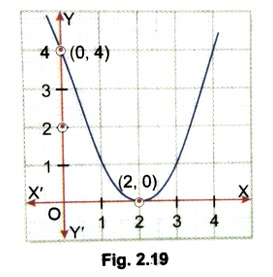Topic Question Set
Q 1
:
The zeroes of the polynomial are
(2)
Let
For zeros of
Its zeros are
Q 2
:
If α and β are the zeros of a polynomial and α + β = αβ, then p is
(2)
Given,
Since and are the zeroes of the given polynomial.
(given)
Q 3
:
The zeroes of a polynomial are twice the zeroes of the polynomial . The value of p is :
(1)
Given polynomials : ...(i)
and ...(ii)
Zero of polynomial are: and
Now, zero of polynomial are 4 and
Sum of zeroes
Q 4
:
Assertion (A): If the graph of a polynomial touches x-axis at only one point, then the polynomial cannot be a quadratic polynomial.
Reason (R): A polynomial of degree n(n >1) can have at most n zeroes.
Both, Assertion (A) and Reason (R) are true and Reason (R) is correct explanation of Assertion (A).
Both, Assertion (A) and Reason (R) are true but Reason (R) is not correct explanation for Assertion (A).
Assertion (A) is true but Reason (R) is false.
Assertion (A) is false but Reason (R) is true.
(4)
The polynomials of the form and has only equal roots and graphs of these polynomials cut x-axis at only one point. These polynomials are quadratic Thus, Assertion is false Reason is true.
Q 5
:
If the sum of zeroes of the polynomial is , then value of is :
(2)
Sum of zeroes
Q 6
:
If and are zeroes of the polynomial , the value of is
−3/7
3/5
3/7
−5/7
(3)
Now,
Q 7
:
Assertion (A): If the graph of a polynomial intersects the x-axis at exactly two points, then the number of zeroes of that polynomial is 2.
Reason (R): The number of zeroes of a polynomial is equal to the number of points where the graph of the polynomial intersects x-axis.
Both Assertion (A) and Reason (R) are true and Reason (R) is the correct explanation of the Assertion (A).
Both Assertion (A) and Reason (R) are true, but Reason (R) is not the correct explanation of the Assertion (A).
Assertion (A) is true, but Reason (R) is false.
Assertion (A) is false, but Reason (R) is true.
(1) Both Assertion (A) and Reason (R) are true and Reason (R) is the correct explanation of the Assertion (A).
Q 8
:
Consider the polynomial Which of the following statements are true about its graph and zeros?
(i) The polynomial has a zero at x = 0.
(ii) The polynomial has a zero at x = 1.
(iii) The graph touches the x-axis at x = 1.
(iv) The graph intersects the x-axis at x = 2.
Choose the correct option from the following:
(ii) The polynomial has a zero at x = 1.
(iii) The graph touches the x-axis at x = 1.
(iv) The graph intersects the x-axis at x = 2.
both (i) and (ii)
both (ii) and (iii)
(i), (ii) and (iv)
both (i) and (iv)
(3)
Factoring p(x) gives x(x – 1)(x – 2), indicating zeros at x = 0, 1, and 2. The graph intersects the x-axis at these points.
Q 9
:
For the polynomial r(x) = x² – 4x + 4, which of the following statements are correct about its graph and zeros?

(i) The graph touches the x-axis at x = 2.
(ii) The graph intersects the x-axis at x = 2.
(iii) The polynomial is equivalent to (x – 2)².
(iv) The vertex of the graph is at the point (2, 0).
Choose the correct option from the following:

(ii) The graph intersects the x-axis at x = 2.
(iii) The polynomial is equivalent to (x – 2)².
(iv) The vertex of the graph is at the point (2, 0).
(i), (iii) and (iv)
(ii) and (iii)
(i), (ii) and (iv)
(i) and (iv)
(1)
Given polynomial r(x) can be rewritten as (x – 2)², indicating a repeated zero at x = 2. The graph touches the x-axis at this point and does not cross it. The vertex of the graph is at point (2, 0).
Q 10
:
For the polynomial t(x) = x³ – 6x² + 11x – 6, which statements are true about its graph and zeros?
(i) The polynomial has a zero at x = 1.
(ii) The polynomial has a zero at x = 2.
(iii) The graph of the polynomial intersects the x-axis at x = 3.
(iv) The polynomial can be factorised as (x – 1)(x – 2)(x – 3).
Choose the correct option from the following:
(ii) The polynomial has a zero at x = 2.
(iii) The graph of the polynomial intersects the x-axis at x = 3.
(iv) The polynomial can be factorised as (x – 1)(x – 2)(x – 3).
(i), (iii) and (iv)
(i), (ii), (iii) and (iv)
(i), (ii) and (iv)
(i) and (iv)
(2)
At x = 1, t(1) = 1 – 6 + 11 – 6 = 0
So (x – 1) is a factor of t(x).
∴ t(x) = (x – 1)(x² – 5x + 6)
⇒ t(x) = (x – 1)(x – 2)(x – 3)
Factoring t(x) as (x – 1)(x – 2)(x – 3) reveals zeros at x = 1, 2, 3. The graph intersects the x-axis at these points.

